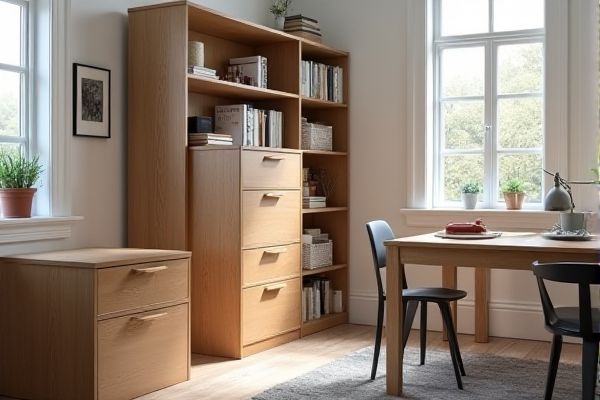
Vertical file cabinets save valuable floor space with their narrow design, making them ideal for smaller offices or tight areas, while lateral file cabinets offer wider drawer space and easier access to files, perfect for larger documents and heavy filing needs. Explore the detailed differences to determine which file cabinet best suits your organizational requirements and enhances Your workspace efficiency.
Table of Comparison
| Feature | Vertical File Cabinet | Lateral File Cabinet |
|---|---|---|
| Orientation | Drawers open front-to-back | Drawers open side-to-side |
| Space Efficiency | Compact, fits narrow spaces | Wider, requires more floor space |
| File Capacity | Stores fewer files per drawer | Stores more files per drawer |
| File Access | Ideal for letter/legal files | Ideal for legal/ledger files |
| Height | Taller, stacks higher | Lower profile |
| Durability | Typically less robust | Usually sturdier and heavier |
| Cost | Generally less expensive | Usually higher cost |
| Common Use | Small offices, limited space | Larger offices, heavy file storage |
Introduction to File Cabinets
Vertical file cabinets feature tall, narrow drawers designed for storing letter or legal-sized documents in a compact footprint, ideal for limited office spaces. Lateral file cabinets have wider drawers that extend from the longer side, allowing for side-to-side filing and easier access to files, suitable for storing large volumes of documents. Both types enhance office organization by providing categorized, secure storage solutions tailored to different spatial and filing needs.
What Is a Vertical File Cabinet?
A vertical file cabinet is a tall, narrow storage unit designed for organizing documents in a space-efficient manner, typically featuring drawers that extend from the front. It is ideal for maximizing vertical space in small offices or rooms while providing easy access to hanging files. Your choice of a vertical file cabinet can enhance organization without occupying much floor area, making it a practical solution for constrained spaces.
What Is a Lateral File Cabinet?
A lateral file cabinet features wide drawers that extend from the longer side, providing easy access to files and maximizing wall space. Its design allows documents to be stored side-to-side, making it ideal for larger offices with ample floor space. Choosing a lateral file cabinet can enhance your organization by offering greater file capacity compared to vertical models.
Key Differences Between Vertical and Lateral File Cabinets
Vertical file cabinets have a narrow footprint with drawers that extend outward, making them ideal for tight spaces, while lateral file cabinets feature wider drawers that slide side-to-side, offering easier access to larger files and greater storage capacity. Vertical cabinets typically accommodate letter-size documents vertically, whereas lateral cabinets can store both letter and legal-sized files horizontally, enhancing organizational flexibility. Your choice depends on available space and file orientation preferences, with vertical cabinets saving floor space and lateral cabinets providing broader drawer space for diverse filing needs.
Space Efficiency: Vertical vs. Lateral
Vertical file cabinets maximize space efficiency in compact areas by utilizing a narrow footprint and taller storage capacity, making them ideal for small offices with limited floor space. Lateral file cabinets offer wider drawers that accommodate letter or legal-sized documents side-by-side, optimizing accessibility without requiring tall storage areas, best suited for larger spaces. Choosing between the two depends on balancing available floor space with the need for document access and storage volume.
Storage Capacity Comparison
Vertical file cabinets optimize storage with deep, narrow drawers ideal for letter and legal-sized documents in limited floor spaces. Lateral file cabinets offer wider drawers that accommodate larger file folders and documents, providing greater overall storage capacity for extensive filing systems. Choosing between the two depends on balancing spatial constraints with required storage volume.
Accessibility and Ease of Use
Vertical file cabinets offer easier access to individual files with narrow drawers ideal for small spaces, enhancing accessibility in compact offices. Lateral file cabinets provide wider drawers that allow files to be spread out side by side, making it simpler to view and organize documents, especially in larger workspaces. The choice between vertical and lateral cabinets depends on office layout and the volume of files requiring quick, frequent access.
Aesthetic and Office Design Considerations
Vertical file cabinets offer a compact, space-saving footprint ideal for narrow office spaces, complementing minimalist or traditional office designs with their tall, slender profile. Lateral file cabinets provide a wider, low-profile aesthetic that enhances modern office layouts, offering a streamlined appearance that doubles as additional workspace or storage surface. Choosing between them depends on the office's spatial constraints and the desired visual balance between functionality and design harmony.
Cost Analysis: Which Cabinet Offers Better Value?
Vertical file cabinets generally cost less upfront compared to lateral file cabinets due to their narrower design and simpler construction. Lateral file cabinets offer better value in terms of storage capacity and accessibility, often reducing the need for multiple units and saving office space in the long run. When considering total cost of ownership, including space efficiency and ease of use, lateral file cabinets tend to provide a more cost-effective solution for larger filing needs.
Choosing the Right File Cabinet for Your Needs
Vertical file cabinets offer a compact footprint ideal for narrow spaces, with drawers that extend from the shorter side, providing easy access to folders stored front-to-back. Lateral file cabinets, wider and with drawers extending from the longer side, maximize storage capacity and allow you to organize documents side-by-side, suitable for larger offices or shared spaces. Selecting the right file cabinet depends on your available floor space, storage volume, and filing preferences to ensure efficient document management.
 homyna.com
homyna.com